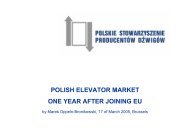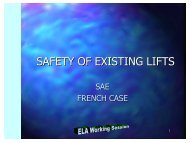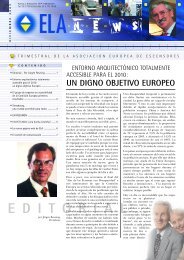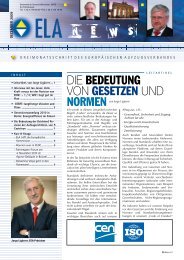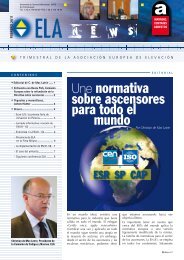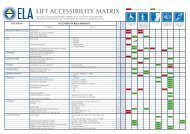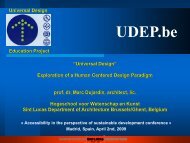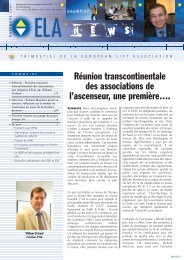WP6-Brochure-E4 brochure - ELA European Lift Association.
WP6-Brochure-E4 brochure - ELA European Lift Association.
WP6-Brochure-E4 brochure - ELA European Lift Association.
You also want an ePaper? Increase the reach of your titles
YUMPU automatically turns print PDFs into web optimized ePapers that Google loves.
vertical transportation is expected to grow in the coming years. <strong>Lift</strong>s are an important mean of<br />
enabling everyone to have access to the built environment (cp. Guide to application of the lift<br />
directive 95/16/EC, §99 [11]).<br />
However, non‐necessary installation and use of lifts is an issue that should also be considered<br />
when energy efficiency for lifts is being discussed. For instance, in hotels or office buildings,<br />
staircases are sometimes hard to find and less attractive to use; thus everybody takes the lift,<br />
even healthy people. However, if staircases were as obviously indicated as the lift it may<br />
sometimes be possible to reduce a bank of lifts from three to two etc. – which may reduce<br />
energy consumed by vertical transportation without limiting accessibility. Campaigns about<br />
the energy efficiency of lifts should also address this issue – without implying a decrease in<br />
accessibility.<br />
Recommendations for escalators<br />
Recommendations for escalators are similar to those for lifts. However, as escalators are<br />
simpler and less diverse systems than lifts, from a technical point of view, and as they are<br />
usually bought by a different, more professional and cost‐conscious customer group, they<br />
should be more easily achieved. First of all, as for lifts, a standard for measuring energy<br />
consumption is needed to provide a baseline for comparison. Second, escalators should also<br />
become subject to relevant regulation regarding energy efficiency. Third, a labelling system<br />
could help raise awareness and provide a basis for decision‐making.<br />
7.2.1 Conclusions<br />
Thus, based on our analyses, we come to the following conclusions regarding a strategy for<br />
market transformation in the lift and escalator market. First of all, a <strong>European</strong> standard for<br />
measuring the energy consumption and calculation of energy demand of lifts and escalators<br />
is needed. This kind of standard is the basis for comparisons between more and less energyefficient<br />
technology and the existence of a standard will already contribute to raise some<br />
awareness. Second, lifts and escalators should become subject to legislation and regulation<br />
concerned with the energy efficiency of buildings, namely, they should become part of the<br />
EPBD. Third, campaigns and material directing attention to the issue of energy efficiency of<br />
lifts and escalators is needed. This third conclusion is to be combined with the fourth,<br />
providing easily accessible and understandable information for buyers of lifts and escalators to<br />
support decision‐making processes. The most important groups to be addressed in these<br />
campaigns are, on the one hand, those involved in decision‐making of installations for new<br />
buildings, i.e. general contractors, architects and construction engineers, on the other hand,<br />
those involved in maintaining lift and escalators services in buildings, building administrators<br />
and operators.<br />
These conclusions are based on the results of our analyses which indicate that energy‐efficient<br />
technology for lifts and escalators is being offered in the market. The main barriers to the<br />
market penetration of these technologies are low levels of awareness and knowledge about<br />
these technologies as well as split incentives.<br />
104



